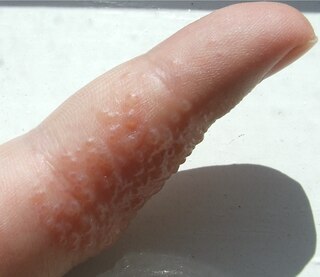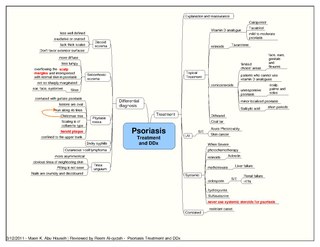| Impetigo herpetiformis | |
|---|---|
| Other names | Pustular psoriasis of pregnancy |
| Specialty | Dermatology, obstetrics |
Impetigo herpetiformis is a form of severe pustular psoriasis occurring in pregnancy [1] [2] which may occur during any trimester. [3] [4]
| Impetigo herpetiformis | |
|---|---|
| Other names | Pustular psoriasis of pregnancy |
| Specialty | Dermatology, obstetrics |
Impetigo herpetiformis is a form of severe pustular psoriasis occurring in pregnancy [1] [2] which may occur during any trimester. [3] [4]
The typical lesions are centrifugally extending erythematous patches with marginally grouped sterile pustules; they can also develop erosion, crust, and impetiginization. These lesions are mainly seen in flexural regions. Patients may experience vegetative lesions resembling Pemphigus vegetans, though they are uncommon. [5] It is possible to see mucosal lesions in the tongue, mouth, and even esophagus in addition to nail involvement. [6]
In impetigo herpetiformis, hypoparathyroidism and hypocalcemia may be encountered. [7] Systematic symptoms such as malaise, hypovolemic shock, vomiting, chills, fever, diarrhea, and seizures may also be seen. [8]
The cause of impetigo herpetiformis is not yet clear. [8] Some evidence suggests that genetic factors may play a role in the development of impetigo herpetiformis, such as the number of familial cases. [9]
The diagnosis of impetigo herpetiformis is supported by clinical and laboratory findings, and histological examination primarily reveals neutrophilc inflammatory infiltrate, epidermal acanthosis, and papillomatosis with focal parakeratosis. [10] Spongiform pustules of Kogoj are intraepidermal multilocular microabscesses that are formed by neutrophil collections. [11]
Laboratory findings include iron deficiency anemia, hypoalbuminemia, hypocalcemia, elevated erythrocyte sedimentation rate, and leukocytosis. [12]
Pustular psoriasis is still primarily treated with systemic corticosteroids, which have been used for many years. [13] If a patient is not responding to corticosteroids, cyclosporine may be a useful medication. [14] In impetigo herpetiformis, the use of antibiotics appears to be beneficial, despite the fact that they cannot completely eradicate the illness. [15] [16]

Psoriasis is a long-lasting, noncontagious autoimmune disease characterized by patches of abnormal skin. These areas are red, pink, or purple, dry, itchy, and scaly. Psoriasis varies in severity from small localized patches to complete body coverage. Injury to the skin can trigger psoriatic skin changes at that spot, which is known as the Koebner phenomenon.

Dyshidrosis is a type of dermatitis that is characterized by itchy blisters on the palms of the hands and bottoms of the feet. Blisters are generally one to two millimeters in size and heal over three weeks. However, they often recur. Redness is not usually present. Repeated attacks may result in fissures and skin thickening.
Dermatoses of pregnancy are the inflammatory skin diseases that are specific to women while they are pregnant. While some use the term 'polymorphic eruption of pregnancy' to cover these, this term is a synonym used in the UK for Pruritic urticarial papules and plaques of pregnancy, which is the commonest of these skin conditions.
Atrophia Maculosa Varioliformis Cutis (AMVC) is an idiopathic noninflammatory macular atrophy subtype that affects young people. Clinically, it is distinguished by a variety of shaped, shallow, sharply demaracated depressions.

The term pustular psoriasis is used for a heterogeneous group of diseases that share pustular skin characteristics.
Chilblain lupus erythematosus was initially described by Hutchinson in 1888 as an uncommon manifestation of chronic cutaneous lupus erythematosus. Chilblain lupus erythematosus is characterized by a rash that primarily affects acral surfaces that are frequently exposed to cold temperatures, such as the toes, fingers, ears, and nose. The rash is defined by oedematous skin, nodules, and tender plaques with a purple discoloration.
Eccrine angiomatous hamartoma (EAH), first described by Lotzbeck in 1859, is a rare benign vascular hamartoma characterized histologically by a proliferation of eccrine and vascular components. EAH exists on a spectrum of cutaneous tumors that include eccrine nevus, mucinous eccrine nevus and EAH. Each diagnostic subtype is characterized by an increase in the number as well as size of mature eccrine glands or ducts, with EAH being distinguished by the added vascular component.

Psoriatic erythroderma represents a form of psoriasis that affects all body sites, including the face, hands, feet, nails, trunk, and extremities. This specific form of psoriasis affects 3 percent of persons diagnosed with psoriasis. First-line treatments for psoriatic erythroderma include immunosuppressive medications such as methotrexate, acitretin, or ciclosporin.
Generalized pustular psoriasis (GPP) is an extremely rare type of psoriasis that can present in a variety of forms. Unlike the most general and common forms of psoriasis, GPP usually covers the entire body and with pus-filled blisters rather than plaques. GPP can present at any age, but is rarer in young children. It can appear with or without previous psoriasis conditions or history, and can reoccur in periodic episodes.

Pustulosis palmaris et plantaris is a chronic recurrent pustular dermatosis localized on the palms and soles only, characterized histologically by intraepidermal pustules filled with neutrophils. It can occur as part of the SAPHO syndrome.

Acute generalized exanthematous pustulosis (AGEP) is a rare skin reaction that in 90% of cases is related to medication.
Perforating granuloma annulare (PGA) is a skin condition of unknown cause, usually appearing on the dorsal hands, presenting as papules with a central keratotic core.
Annular elastolytic giant-cell granuloma is a cutaneous condition characterized histologically by a dermal infiltrate of macrophages.
Idiopathic facial aseptic granuloma is a cutaneous condition characterized by a chronic, painless, solitary nodule, reminiscent of an acne nodule, appearing on the cheeks of young children. It has a prolonged course, but spontaneously heals.

Congenital cartilaginous rest of the neck (CCRN) is a minor and very rare congenital cutaneous condition characterized by branchial arch remnants that are considered to be the cervical variant of accessory tragus. It resembles a rudimentary pinna that in most cases is located in the lower anterior part of the neck.
Granuloma gluteale infantum is a cutaneous condition that appears in the anogenital region of infants as a complication of diaper dermatitis. According to some, no granulomas are found.
Neonatal hypocalcemia is an abnormal clinical and laboratory hypocalcemia condition that is frequently observed in infants. It is commonly presented within the first 72 hours of a newborn's life. Neonatal hypocalcemia can cause seizures in infants requiring a calcium infusion until homeostasis is achieved; allowing for positive clinical outcomes within weeks of treatment.
Von Zumbusch (acute) generalized pustular psoriasis is the most severe form of generalized pustular psoriasis, and can be associated with life-threatening complications.
Neonatal pustular eruptions are a group of disorders characterized by various forms of pustulosis seen in the first four weeks of life.